Andrew L. Orekhov
Autonomously Unweaving Multiple Cables Using Visual Feedback
Dec 13, 2025Abstract:Many cable management tasks involve separating out the different cables and removing tangles. Automating this task is challenging because cables are deformable and can have combinations of knots and multiple interwoven segments. Prior works have focused on untying knots in one cable, which is one subtask of cable management. However, in this paper, we focus on a different subtask called multi-cable unweaving, which refers to removing the intersections among multiple interwoven cables to separate them and facilitate further manipulation. We propose a method that utilizes visual feedback to unweave a bundle of loosely entangled cables. We formulate cable unweaving as a pick-and-place problem, where the grasp position is selected from discrete nodes in a graph-based cable state representation. Our cable state representation encodes both topological and geometric information about the cables from the visual image. To predict future cable states and identify valid actions, we present a novel state transition model that takes into account the straightening and bending of cables during manipulation. Using this state transition model, we select between two high-level action primitives and calculate predicted immediate costs to optimize the lower-level actions. We experimentally demonstrate that iterating the above perception-planning-action process enables unweaving electric cables and shoelaces with an 84% success rate on average.
Unsupervised Deformable Image Registration for Respiratory Motion Compensation in Ultrasound Images
Jun 23, 2023Abstract:In this paper, we present a novel deep-learning model for deformable registration of ultrasound images and an unsupervised approach to training this model. Our network employs recurrent all-pairs field transforms (RAFT) and a spatial transformer network (STN) to generate displacement fields at online rates (apprx. 30 Hz) and accurately track pixel movement. We call our approach unsupervised recurrent all-pairs field transforms (U-RAFT). In this work, we use U-RAFT to track pixels in a sequence of ultrasound images to cancel out respiratory motion in lung ultrasound images. We demonstrate our method on in-vivo porcine lung videos. We show a reduction of 76% in average pixel movement in the porcine dataset using respiratory motion compensation strategy. We believe U-RAFT is a promising tool for compensating different kinds of motions like respiration and heartbeat in ultrasound images of deformable tissue.
Unsupervised Deformable Ultrasound Image Registration and Its Application for Vessel Segmentation
Jun 23, 2023Abstract:This paper presents a deep-learning model for deformable registration of ultrasound images at online rates, which we call U-RAFT. As its name suggests, U-RAFT is based on RAFT, a convolutional neural network for estimating optical flow. U-RAFT, however, can be trained in an unsupervised manner and can generate synthetic images for training vessel segmentation models. We propose and compare the registration quality of different loss functions for training U-RAFT. We also show how our approach, together with a robot performing force-controlled scans, can be used to generate synthetic deformed images to significantly expand the size of a femoral vessel segmentation training dataset without the need for additional manual labeling. We validate our approach on both a silicone human tissue phantom as well as on in-vivo porcine images. We show that U-RAFT generates synthetic ultrasound images with 98% and 81% structural similarity index measure (SSIM) to the real ultrasound images for the phantom and porcine datasets, respectively. We also demonstrate that synthetic deformed images from U-RAFT can be used as a data augmentation technique for vessel segmentation models to improve intersection-over-union (IoU) segmentation performance
Design Considerations and Robustness to Parameter Uncertainty in Wire-Wrapped Cam Mechanisms
Jun 22, 2023Abstract:Collaborative robots must simultaneously be safe enough to operate in close proximity to human operators and powerful enough to assist users in industrial tasks such as lifting heavy equipment. The requirement for safety necessitates that collaborative robots are designed with low-powered actuators. However, some industrial tasks may require the robot to have high payload capacity and/or long reach. For collaborative robot designs to be successful, they must find ways of addressing these conflicting design requirements. One promising strategy for navigating this tradeoff is through the use of static balancing mechanisms to offset the robot's self weight, thus enabling the selection of lower-powered actuators. In this paper, we introduce a novel, 2 degree of freedom static balancing mechanism based on spring-loaded, wire-wrapped cams. We also present an optimization-based cam design method that guarantees the cams stay convex, ensures the springs stay below their extensions limits, and minimizes sensitivity to unmodeled deviations from the nominal spring constant. Additionally, we present a model of the effect of friction between the wire and the cam. Lastly, we show experimentally that the torque generated by the cam mechanism matches the torque predicted in our modeling approach. Our results also suggest that the effects of wire-cam friction are significant for non-circular cams.
Task and Configuration Space Compliance of Continuum Robots via Lie Group and Modal Shape Formulations
Jun 22, 2023Abstract:Continuum robots suffer large deflections due to internal and external forces. Accurate modeling of their passive compliance is necessary for accurate environmental interaction, especially in scenarios where direct force sensing is not practical. This paper focuses on deriving analytic formulations for the compliance of continuum robots that can be modeled as Kirchhoff rods. Compared to prior works, the approach presented herein is not subject to the constant-curvature assumptions to derive the configuration space compliance, and we do not rely on computationally-expensive finite difference approximations to obtain the task space compliance. Using modal approximations over curvature space and Lie group integration, we obtain closed-form expressions for the task and configuration space compliance matrices of continuum robots, thereby bridging the gap between constant-curvature analytic formulations of configuration space compliance and variable curvature task space compliance. We first present an analytic expression for the compliance of a single Kirchhoff rod. We then extend this formulation for computing both the task space and configuration space compliance of a tendon-actuated continuum robot. We then use our formulation to study the tradeoffs between computation cost and modeling accuracy as well as the loss in accuracy from neglecting the Jacobian derivative term in the compliance model. Finally, we experimentally validate the model on a tendon-actuated continuum segment, demonstrating the model's ability to predict passive deflections with error below 11.5\% percent of total arc length.
Lie Group Formulation and Sensitivity Analysis for Shape Sensing of Variable Curvature Continuum Robots with General String Encoder Routing
Dec 23, 2022Abstract:This paper considers a combination of actuation tendons and measurement strings to achieve accurate shape sensing and direct kinematics of continuum robots. Assuming general string routing, a methodical Lie group formulation for the shape sensing of these robots is presented. The shape kinematics is expressed using arc-length-dependent curvature distributions parameterized by modal functions, and the Magnus expansion for Lie group integration is used to express the shape as a product of exponentials. The tendon and string length kinematic constraints are solved for the modal coefficients and the configuration space and body Jacobian are derived. The noise amplification index for the shape reconstruction problem is defined and used for optimizing the string/tendon routing paths, and a planar simulation study shows the minimal number of strings/tendons needed for accurate shape reconstruction. A torsionally stiff continuum segment is used for experimental evaluation, demonstrating mean (maximal) end-effector absolute position error of less than 2% (5%) of total length. Finally, a simulation study of a torsionally compliant segment demonstrates the approach for general deflections and string routings. We believe that the methods of this paper can benefit the design process, sensing and control of continuum and soft robots.
Kinematic Modeling and Compliance Modulation of Redundant Manipulators Under Bracing Constraints
Aug 11, 2020

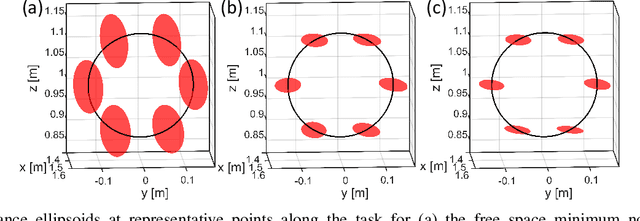

Abstract:Collaborative robots should ideally use low torque actuators for passive safety reasons. However, some applications require these collaborative robots to reach deep into confined spaces while assisting a human operator in physically demanding tasks. In this paper, we consider the use of in-situ collaborative robots (ISCRs) that balance the conflicting demands of passive safety dictating low torque actuation and the need to reach into deep confined spaces. We consider the judicious use of bracing as a possible solution to these conflicting demands and present a modeling framework that takes into account the constrained kinematics and the effect of bracing on the end-effector compliance. We then define a redundancy resolution framework that minimizes the directional compliance of the end-effector while maximizing end-effector dexterity. Kinematic simulation results show that the redundancy resolution strategy successfully decreases compliance and improves kinematic conditioning while satisfying the constraints imposed by the bracing task. Applications of this modeling framework can support future research on the choice of bracing locations and support the formation of an admittance control framework for collaborative control of ISCRs under bracing constraints. Such robots can benefit workers in the future by reducing the physiological burdens that contribute to musculoskeletal injury.
Solving Cosserat Rod Models via Collocation and the Magnus Expansion
Aug 11, 2020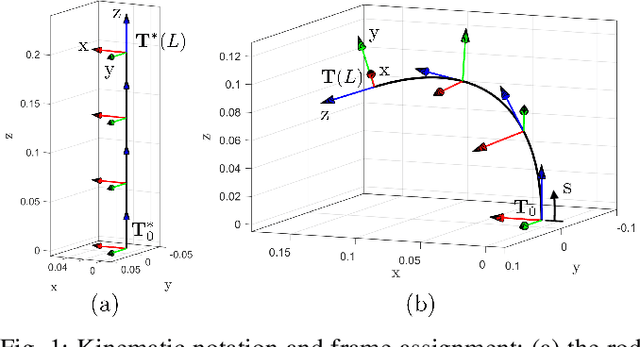
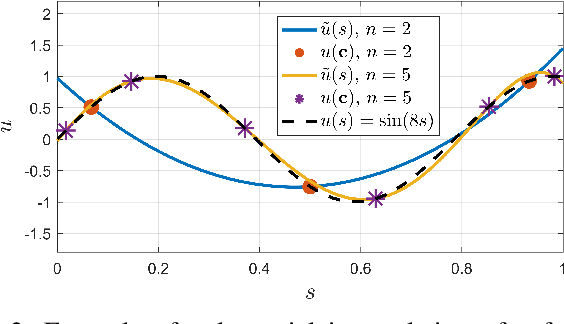
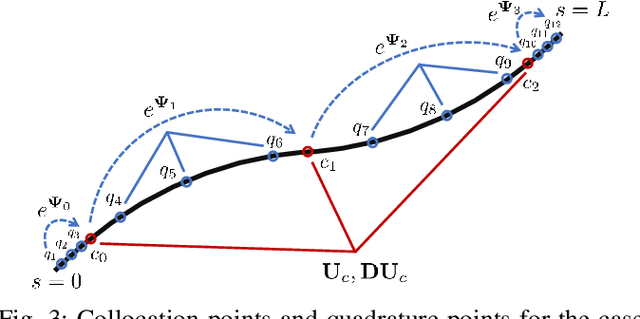

Abstract:Choosing a kinematic model for a continuum robot typically involves making a tradeoff between accuracy and computational complexity. One common modeling approach is to use the Cosserat rod equations, which have been shown to be accurate for many types of continuum robots. This approach, however, still presents significant computational cost, particularly when many Cosserat rods are coupled via kinematic constraints. In this work, we propose a numerical method that combines orthogonal collocation on the local rod curvature and forward integration of the Cosserat rod kinematic equations via the Magnus expansion, allowing the equilibrium shape to be written as a product of matrix exponentials. We provide a bound on the maximum step size to guarantee convergence of the Magnus expansion for the case of Cosserat rods, compare in simulation against other approaches, and demonstrate the tradeoffs between speed and accuracy for the fourth and sixth order Magnus expansions as well as for different numbers of collocation points. Our results show that the proposed method can find accurate solutions to the Cosserat rod equations and can potentially be competitive in computation speed.
Snake-Like Robots for Minimally Invasive, Single Port, and Intraluminal Surgeries
Jun 11, 2019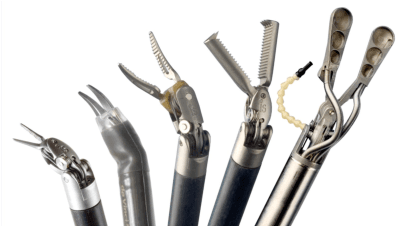
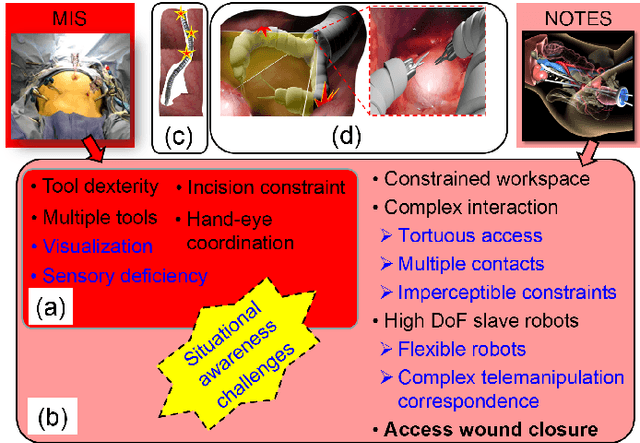
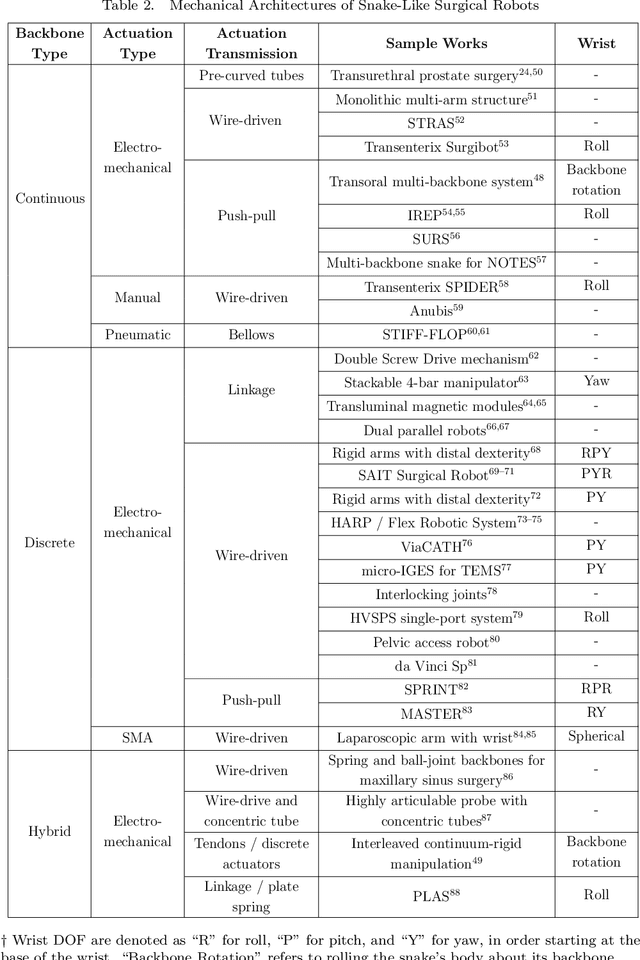

Abstract:The surgical paradigm of Minimally Invasive Surgery (MIS) has been a key driver to the adoption of robotic surgical assistance. Progress in the last three decades has led to a gradual transition from manual laparoscopic surgery with rigid instruments to robot-assisted surgery. In the last decade, the increasing demand for new surgical paradigms to enable access into the anatomy without skin incision (intraluminal surgery) or with a single skin incision (Single Port Access surgery - SPA) has led researchers to investigate snake-like flexible surgical devices. In this chapter, we first present an overview of the background, motivation, and taxonomy of MIS and its newer derivatives. Challenges of MIS and its newer derivatives (SPA and intraluminal surgery) are outlined along with the architectures of new snake-like robots meeting these challenges. We also examine the commercial and research surgical platforms developed over the years, to address the specific functional requirements and constraints imposed by operations in confined spaces. The chapter concludes with an evaluation of open problems in surgical robotics for intraluminal and SPA, and a look at future trends in surgical robot design that could potentially address these unmet needs.
* 41 pages, 18 figures. Preprint of article published in the Encyclopedia of Medical Robotics 2018, World Scientific Publishing Company www.worldscientific.com/doi/abs/10.1142/9789813232266_0008
 Add to Chrome
Add to Chrome Add to Firefox
Add to Firefox Add to Edge
Add to Edge